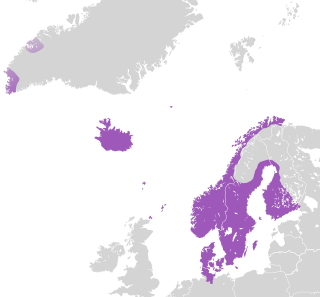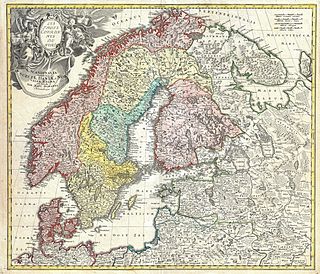
The Hanseatic League was a medieval commercial and defensive confederation of merchant guilds and market towns in Central and Northern Europe. Growing from a few North German towns in the late 12th century, the League expanded between the 13th and 15th centuries and ultimately encompassed nearly 200 settlements across nine modern-day countries, ranging from Estonia in the north and east, to King's Lynn, England in the west, and Kraków, Poland, in the south.

The Kalmar Union was a personal union in Scandinavia, agreed at Kalmar in Sweden as designed by widowed Queen Margaret of Norway and Sweden. From 1397 to 1523, it joined under a single monarch the three kingdoms of Denmark, Sweden, and Norway, together with Norway's overseas colonies.

The history of Denmark as a unified kingdom began in the 8th century, but historic documents describe the geographic area and the people living there—the Danes—as early as 500 AD. These early documents include the writings of Jordanes and Procopius. With the Christianization of the Danes c. 960 AD, it is clear that there existed a kingship. King Frederik X can trace his lineage back to the Viking kings Gorm the Old and Harald Bluetooth from this time, thus making the Monarchy of Denmark the oldest in Europe. The area now known as Denmark has a rich prehistory, having been populated by several prehistoric cultures and people for about 12,000 years, since the end of the last ice age.

The Treaty of Stralsund ended the Danish-Hanseatic War between the Hanseatic League and the kingdom of Denmark. The Hanseatic League reached the peak of its power by the conditions of this treaty.
The Skåne Market or Scania market was a major fish market for herring which took place annually in Scania during the Middle Ages. From around 1200, it became one of the most important events for trade around the Baltic Sea and made Scania into a major distribution center for West-European goods bound for eastern Scandinavia. The Scania Market continued to be an important trade center for 250 years and was a cornerstone of the Hanseatic League's wealth.

The Kalmar War (1611–1613) was a war between Denmark–Norway and Sweden. Though Denmark-Norway soon gained the upper hand, it was unable to defeat Sweden entirely. The Kalmar War was the last time Denmark-Norway successfully defended its dominium maris baltici against Sweden, and it also marked the increasing influence of the two countries on Baltic politics.

Indre By, also known as Copenhagen Center or K or Downtown Copenhagen, is an administrative district (bydel) in central Copenhagen, the capital of Denmark. It covers an area of 4.65 square kilometres (1.80 sq mi), has a population of 26,223, and a population density of 5,638 per km².

The Dutch–Hanseatic War was a conflict between the County of Holland, acting independently of the rest of the Burgundian Netherlands of which it formed part, and the Hanseatic League. It led to little actual fighting, with a Dutch fleet patrolling Øresund while a Hanseatic fleet blocked their access to the Baltic Sea. It ended after Eric of Pomerania was forced from the throne of Denmark in 1440, and the new king Christopher of Bavaria sought a resolution. Peace was concluded in 1441 with the Treaty of Copenhagen.

The North Sea has an extensive history of maritime commerce, resource extraction, and warfare between among the people and nations on its coasts.

The Treaty of Utrecht was signed in 1474 after the Anglo-Hanseatic War between England and the Hanseatic League.

The Confederation of Cologne was a medieval military alliance formed to combat the Kingdom of Denmark. It was established on November 19, 1367 by several cities in the Hanseatic League, several cities in Holland and Zeeland, and towns in Zuiderzee.

Denmark–Norway was an early modern multi-national and multi-lingual real union consisting of the Kingdom of Denmark, the Kingdom of Norway, the Duchy of Schleswig, and the Duchy of Holstein. The state also claimed sovereignty over three historical peoples: Frisians, Gutes and Wends. Denmark–Norway had several colonies, namely the Danish Gold Coast, the Nicobar Islands, Serampore, Tharangambadi, and the Danish West Indies. The union was also known as the Dano-Norwegian Realm, Twin Realms (Tvillingerigerne) or the Oldenburg Monarchy (Oldenburg-monarkiet).
Treaty of Copenhagen may refer to:
The Treaty of Elbing was signed between the Dutch Republic and the Swedish Empire on 1 September (OS) / 11 September 1656, during the Second Northern War, in Swedish-held Elbing (Elbląg). It served to protect Dutch interests in the Baltic Sea, ended the Dutch intervention in the Swedish siege of Danzig, and renewed a fragile peace between the Dutch Republic and Sweden. Within the former, there was opposition to the treaty demanding elucidations, which were agreed upon only on 29 November (OS) / 9 December 1659 in the Convention of Helsingör. Earlier in 1659, in the Concert of The Hague, England, France, and the Dutch Republic had agreed to include the treaty of Elbing in their common agenda regarding the Second Northern War.
The Concert of The Hague, signed on 21 May 1659, was an outline of the common stance of England, France and the Dutch Republic regarding the Second Northern War. The powers agreed that the Swedish Empire and Denmark–Norway should settle for a peace treaty based on the Treaty of Roskilde, including free navigation through The Sound and the Baltic Sea based on the Treaty of Elbing. The subsequent Dano-Swedish Peace of Copenhagen largely followed the terms dictated by the Concert of the Hague.

The establishment of a dominium maris baltici was one of the primary political aims of the Danish and Swedish kingdoms in the late medieval and early modern eras. Throughout the Northern Wars the Danish and Swedish navies played a secondary role, as the dominium was contested through control of key coasts by land warfare.

The Treaties of Roskilde of 18 and 22 November 1568 were peace treaties between the kingdoms of Denmark–Norway and the allied Free and Hanseatic City of Lübeck on one side, and the Swedish kingdom on the other side, supposed to end the Northern Seven Years' War after the de facto succession of the later king John III of Sweden. Negotiated on John's initiative, he refused ratification, viewing the concessions his envoys made in Roskilde as too far-reaching. Most notably these concessions included Swedish obligations to pay Denmark–Norway her war costs and to cede Swedish Estonia. Thus, the war dragged on until it was concluded by the Treaty of Stettin (1570).

The Dano-Hanseatic War, also known as the Kalmar War with the Hanseatic League, or the Danish-Hanseatic War of 1426-1435, was an armed trade conflict between the Danish-dominated Kalmar Union and the Hanseatic League led by the Free City of Lübeck.
Baltic maritime trade began in the Late Middle Ages and continued to develop into the early modern period. During this time, ships carrying goods from the Baltic and North Sea passed along the Øresund, or the Sound, connecting areas like the Gulf of Finland to the Skagerrak. Over a period of 400 years, maritime powers in the east and west struggled to control these markets and the trade routes between them. The Baltic trading system of this era can be explained as beginning with the Hanseatic League and ending with the Great Nordic War.

The Danish-Hanseatic War (1361–1370) was both a trade and territorial conflict mainly between the Kingdom of Denmark, led by King Valdemar IV, and the Hanseatic League, the latter of which was led by the rich and powerful merchant city of Lübeck. Though the first few years of the war resulted in several Danish victories, and even led to a beneficial truce for Denmark in 1365, the Hanseatic League, furious at the terms of the truce, resumed hostilities along with several allies and managed to defeat the Danes.